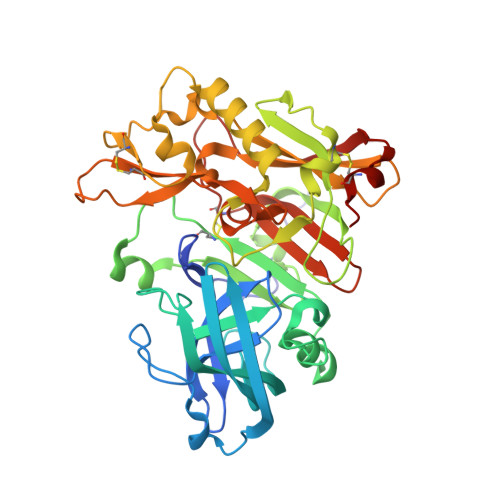Application of Fragment-Based NMR Screening, X-ray Crystallography, Structure-Based Design, and Focused Chemical Library Design to Identify Novel muM Leads for the Development of nM BACE-1 (beta-Site APP Cleaving Enzyme 1) Inhibitors.
Wang, Y.S., Strickland, C., Voigt, J.H., Kennedy, M.E., Beyer, B.M., Senior, M.M., Smith, E.M., Nechuta, T.L., Madison, V.S., Czarniecki, M., McKittrick, B.A., Stamford, A.W., Parker, E.M., Hunter, J.C., Greenlee, W.J., Wyss, D.F.(2010) J Med Chem 53: 942-950
- PubMed: 20043700
- DOI: https://doi.org/10.1021/jm901472u
- Primary Citation of Related Structures:
3KMX, 3KMY, 3KN0 - PubMed Abstract:
Fragment-based NMR screening, X-ray crystallography, structure-based design, and focused chemical library design were used to identify novel inhibitors for BACE-1. A rapid optimization of an initial NMR hit was achieved by a combination of NMR and a functional assay, resulting in the identification of an isothiourea hit with a K(d) of 15 microM for BACE-1. NMR data and the crystal structure revealed that this hit makes H-bond interactions with the two catalytic aspartates, occupies the nonprime side region of the active site of BACE-1, and extends toward the S3 subpocket (S3sp). A focused NMR-based search for heterocyclic isothiourea isosteres resulted in several distinct classes of BACE-1 active site directed compounds with improved chemical stability and physicochemical properties. The strategy for optimization of the 2-aminopyridine lead series to potent inhibitors of BACE-1 was demonstrated. The structure-based design of a cyclic acylguanidine lead series and its optimization into nanomolar BACE-1 inhibitors are the subject of the companion paper
- Schering-Plough Research Institute, 320 Bent Street, Cambridge, Massachusetts 02141, USA. allen.yu-sen.wang@spcorp.com
Organizational Affiliation:

















